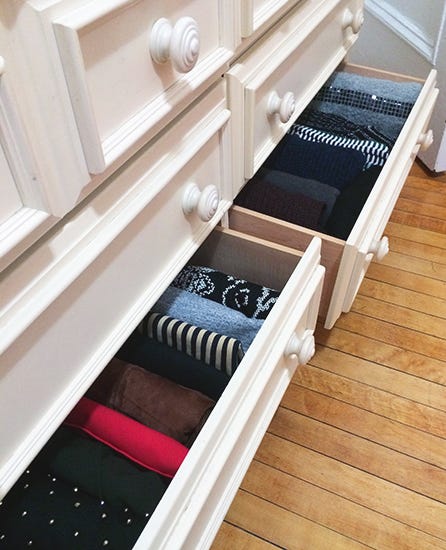So What, Who Cares (vol 2, issue 45) How bargain hunters can benefit from KonMari
Hello! I hope your week is going well and the detox from the peanut butter eggs is going as smoothly as possible. Also, I am still writing over at Previously.TV and doing The Flash flashcasts over at the Incomparable, just in case hearing from me three times a week just isn't enough.
*

A topic that's been surging in self-helpish circles has been the KonMari method, a purge-your-possessions approach engineered by Marie Kondo and popularized in her book, The Life-Changing Magic of Tidying Up. The Kon-Mari method is admirably simple: Look at every item you own. Does it spark joy? If not, don't keep it. The connection between physical order and emotional serenity is made very clear.
There are critics of this approach, who point out that chucking perfectly good things runs counter to the virtue of thrift (how many of us grew up with "use it up, wear it out, make it do, do without?") As Lisa Miller writes:
[O]bjects have value because you bought them with your own hard-earned money or acquired them through fate or some stroke of savvy, and if they’re not totally broken or torn, their merit is intrinsic. Objects are worthy if they’re useful, and — conversely — a use can be invented or imagined for almost every thing.
As I've read through the tide of KonMari coverage and watched friends subject their stuff to the "Does it bring me joy?" test, my one big question has been, "Where do all the joy-sucking objects go once they're released from their owners?"
The clothing's going to secondhand retailers who move trendy or name-brand goods. Fashionista reports:
Secondhand e-tailer Poshmark had almost a half billion dollars of fresh inventory listed on its site in the first quarter of 2015, a 60 percent jump from the previous quarter. According to a Poshmark spokesperson, that number was much higher than what had been projected (even recognizing that the new year is always a time when people like to get rid of stuff). “For a variety of reasons, including the popularity of methods such as KonMari, women on Poshmark are already making some serious cash this year,” the spokesperson wrote in an email to Fashionista.
So what? The KonMari method is the latest in mindful decluttering trends, and it's fun to see how it's rippling across the retail industry. Americans love their stuff, but they also love finding ways to manage their stuff, which is why we have a $22 billion self-storage market and the Container Store made $750 million in sales in 2013.
The other takeaway is that KonMari practitioners want to unload their stuff. There is a market for swooping in and generously offering to take their joyless clutter away.
Who cares? Resale markets. Fast fashion has been tough on old-school thrift stores, because consumers used to paying $3 for a brand-new tank top wouldn't dream of paying more for a used one, regardless of the label or how superior the fabric or sewing. With a glut of clothing coming from KonMari practitioners, there may be issues with inventory management.
On the other hand, savvy resellers can target high-end declutterers and offer to help them unload those not-so-joyful items.

Another aspect to consider: The environmental impact of decluttering. In the U.S., the volume of donated clothing is so great, only an estimated 20% makes it to thrift store shelves. There are businesses devoted to secondary materials/textiles resale and export, meaning that old clothes can be re-purposed for industrial cloth purposes or for insulation material.
The U.S. generates 25 billion pounds of new textiles every year -- or 82 pounds of new textiles per every U.S. resident. (To be fair, "textiles" also includes household linens.) What are we doing with our old stuff? In 2013, the U.S. exported approximately 17 tons of secondhand apparel to other countries, according to Department of Commerce stats.
However, the fabric resale trade pros say Americans are chucking 12.4 million tons of clothing into landfills every year. They say that sustainability in the U.S. apparel market is more likely to be effective if it's baked into the supply chain, because it's not likely to happen on the consumer end without a lot of education -- or a streamlined recycling/donation process.
As Mauricio Hernandez, senior vice president of retail sales for Goodwill Industries, said of the difficulty in setting up clothing recyling programs, "People want to do good, but they don't want to be troubled by it. Convenience is a very big issue."
ARE YOU DOING KONMARI? Has it changed your life? Do you have a system for your stuff? Dish with me via email or Twitter.
*
Your pop culture moment of the day ... will return. I am up to my eyeballs in Day Job stuff this week -- and a few ambitious home improvement projects! Simultaneously! -- and there has been little time for indulging in pop culture.
*
Are there typos? I apologize in advance. The only editing class I did not get an A in was copyediting.
Did you miss an issue of So What, Who Cares? The archive is here.
Would you like a run-down of all the books and other pop culture picks ever mentioned in this newsletter? Then check out the Pinterest board. (Note: None of the links are affiliate links; I do not make money off anything I link to.)
If you really like So What, Who Cares?, tell a friend to subscribe.

